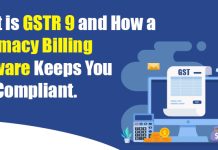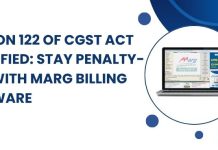The Goods and Services Tax (GST) was introduced in India on 1st July 2017. GST is a value-added tax levied on goods and services that replaces various indirect taxes previously levied by the state and central governments. One of the schemes under GST is the Composite Scheme, which is designed to simplify the compliance requirements for small taxpayers.
What is the Composite Scheme under GST?
The Composite Scheme is a special scheme designed for small businesses with an annual turnover of up to Rs. 1.5 crore. The scheme is optional and allows businesses to pay a fixed percentage of their turnover as tax. Under the Composite Scheme, taxpayers are required to file quarterly returns instead of monthly returns.
Benefits of the Composite Scheme: The Composite Scheme is beneficial for small taxpayers for several reasons. Here are some of the advantages of the Composite Scheme:
- Reduced Compliance Burden: Small taxpayers have limited resources and expertise to comply with complex GST regulations. The Composite Scheme simplifies the compliance requirements and reduces the compliance burden on small taxpayers.
- Lower Tax Liability: The tax rate under the Composite Scheme is lower than the regular GST rates. For example, the tax rate under the Composite Scheme for manufacturers and traders is 1% of the turnover, while for restaurants, it is 5%. This lower tax liability helps small taxpayers to save money and invest in their businesses.
- No Input Tax Credit: Under the Composite Scheme, taxpayers cannot claim the input tax credit on the purchases made for their businesses. However, the reduced tax liability compensates for the loss of input tax credit.
Eligibility Criteria for the Composite Scheme: Not all taxpayers are eligible to opt for the Composite Scheme. Here are the eligibility criteria for the Composite Scheme:
- Annual Turnover: Taxpayers with an annual turnover of up to Rs. 1.5 crore can opt for the Composite Scheme. However, this turnover limit does not apply to businesses operating in the northeastern and hilly states of India. The turnover limit for these states is Rs. 75 lacks.
- Nature of Business: The Composite Scheme is available for businesses engaged in the supply of goods or services or both, except for the following:
a. Interstate supply of goods b. E-commerce operators c. Manufacturers of ice cream, pan masala, or tobacco products d. Casual taxable persons or non-resident taxable persons
- Registration: Taxpayers who are already registered under GST can opt for the Composite Scheme by filing Form GST CMP-02.
How to Calculate Tax Liability under the Composite Scheme?
Taxpayers registered under the Composite Scheme are required to pay tax based on their turnover. The tax rate for manufacturers and traders is 1% of the turnover, while for restaurants, it is 5% of the turnover. The turnover includes all taxable supplies made by the taxpayer, except for the exempt supplies.
Taxpayers registered under the Composite Scheme are not allowed to collect tax from their customers. This means that the tax liability is to be paid by the taxpayer out of their pocket.
The tax liability under the Composite Scheme is calculated as follows:
Tax Liability = Turnover x Tax Rate
For example, if a manufacturer has a turnover of Rs. 50 lakh, the tax liability would be Rs. 50,000 (i.e., 1% of Rs. 50 lacks).
Limitations of the Composite Scheme:
The Composite Scheme has some limitations that taxpayers should consider before opting for the scheme. Here are some of the limitations of the Composite Scheme:
- No Input Tax Credit: Taxpayers registered under the Composite Scheme are not eligible to claim the input tax credit on their purchases. This can be a significant loss for businesses that have a high input tax credit, as they would not be able to offset the tax paid on their purchases against their tax liability.
- Limited Business Scope: Taxpayers registered under the Composite Scheme are not allowed to make inter-state supplies or supply goods through e-commerce operators. This can limit the business scope of the taxpayers who opt for the scheme.
- Higher Tax Liability for Service Providers: Service providers registered under the Composite Scheme are required to pay a higher tax rate of 5% on their turnover. This higher tax liability can be a disadvantage for service providers.
Conclusion:
The Composite Scheme is a beneficial scheme for small taxpayers who have limited resources to comply with the complex GST regulations. The scheme simplifies the compliance requirements and reduces the tax liability for small taxpayers. However, taxpayers should consider the limitations of the scheme before opting for it. Overall, the Composite Scheme is a good option for small taxpayers who meet the eligibility criteria and want to simplify their GST compliance.
Other Related Blogs: Section 144B Income Tax Act
Frequently Asked Questions:
Q:1 What is the composite scheme under GST?
A: The composite scheme is a scheme under GST for small taxpayers who have a turnover of up to Rs. 1.5 crore. It provides for a simplified compliance system and a lower tax rate.
Q:2 Who can opt for the composite scheme under GST? A: The composite scheme is available to taxpayers who have a turnover of up to Rs. 1.5 crore in the previous financial year. It applies to all types of businesses, except for certain specified businesses such as manufacturers of ice cream, pan masala, or tobacco.
Q:3 What are the benefits of the composite scheme under GST?
A: The benefits of the composite scheme include a lower tax rate, simplified compliance requirements, and reduced paperwork. Taxpayers who opt for the composite scheme are also not required to maintain detailed records of their purchases and sales.
Q:4 What is the tax rate under the composite scheme?
A: The tax rate under the composite scheme is lower than the regular GST rate. For traders and manufacturers, it is 1% of the turnover, while for restaurants, it is 5% of the turnover.
Q:5 Can a taxpayer opt for the composite scheme mid-way through a financial year?
A: Yes, a taxpayer can opt for the composite scheme mid-way through a financial year. However, the option once exercised cannot be withdrawn during the same financial year.
Q:6 Can a taxpayer claim input tax credit (ITC) under the composite scheme?
A: No, a taxpayer who opts for the composite scheme cannot claim an input tax credit (ITC) on their purchases.
Q:7 What are the compliance requirements for taxpayers under the composite scheme?
A: Taxpayers under the composite scheme are required to file a quarterly return in FORM GSTR-4. They are also required to pay taxes every quarter.
Q:8 How long can a taxpayer continue under the composite scheme?
A: A taxpayer can continue under the composite scheme until their turnover exceeds Rs. 1.5 crore in a financial year. Once the turnover exceeds this threshold, the taxpayer will be required to register under the regular GST scheme.






